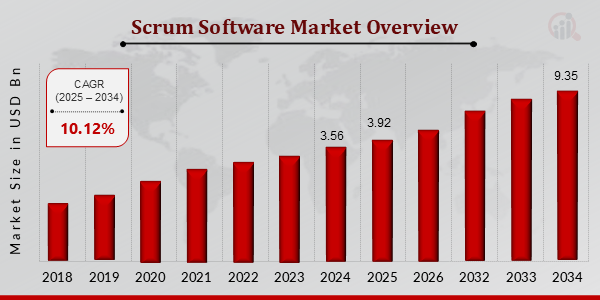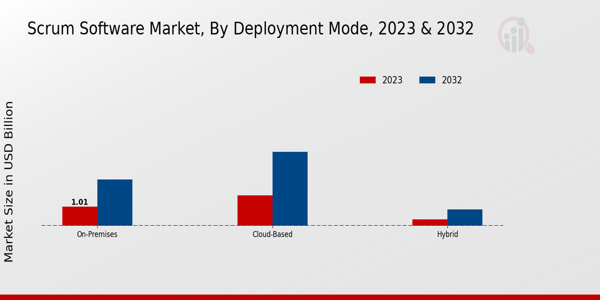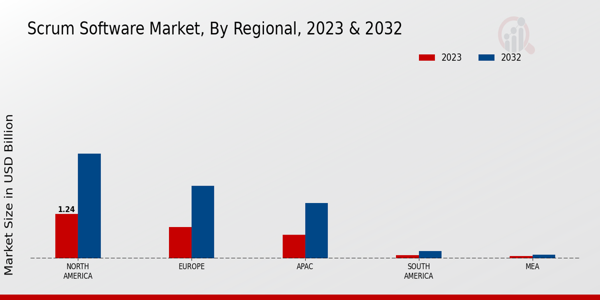Scrum Software Market Overview
Scrum Software Market is projected to grow from USD 3.92 Billion in 2025 to USD 9.35 Billion by 2034, exhibiting a compound annual growth rate (CAGR) of 10.12% during the forecast period (2025 - 2034). Additionally, the market size for Scrum Software Market was valued at USD 3.56 billion in 2024.
Key Scrum Software Market Trends Highlighted
The Scrum Software Market is on the rise owing to the rising interest in agile project management paradigms across industries. Companies are looking to increase collaboration, productivity, and speed of product delivery through the adoption of Scrum. This trend is largely due to the fact that businesses have to respond rapidly to shifts in market conditions and consumer behavior. Even the push towards digital transformation is underlined as an important factor as it causes businesses to look for advanced tools that increase the efficiency of their activities and the cooperation of the team members. In the domain of Scrum software, opportunities are also available for entering new economies where companies are starting to use agile methods for efficiency and competitiveness.
With the shift of organizations toward remote job positions or hybrid working environments, a need for solid Scrum tools that enhance virtual interaction has increased. Also, it would be interesting to explore the evolution of Scrum software with the inclusion of AI and machine learning to improve the technology’s capabilities and decision-making processes. Recently, the inclination to the development of more configurable and simple scrumm software has gained momentum.
Companies are looking for solutions that are suitable for individual processes and structures within the teams, resulting in better usage and involvement of people. In addition, the increasing popularity of software subscription sales is revolutionizing the scenario, allowing even the youngest enterprises to grab sophisticated Scrum tools. While advances in Scrum tools help employers accomplish management goals, they foster a greater emphasis on time-sensitive metrics in Scrum websites so that teams can work and improve their performance on the same basis.
Figure 1 Scrum Software Market Overview (2025-2034)

Source: Primary Research, Secondary Research, MRFR Database and Analyst Review
Scrum Software Market Drivers
Increasing Adoption of Agile Methodologies
The Scrum Software Market Industry is significantly benefitting from the increasing adoption of Agile methodologies by organizations across various sectors. As businesses seek to improve efficiency, enhance team collaboration, and deliver quality products faster, Agile practices, particularly Scrum, are becoming more popular. The evolution of the software development landscape has resulted in a shift from traditional methodologies to Agile frameworks, making Scrum a favored choice due to its focus on iterative progress and quick adaptation to changes.Companies are recognizing that Agile not only streamlines their processes but also aligns better with modern customer demands for rapid delivery and continuous improvement.
As more organizations implement Agile frameworks, the demand for comprehensive Scrum software solutions rises, driving the growth of the Scrum Software Market Industry. This shift is also supported by the rising number of software training programs that emphasize Agile methodologies, creating a well-versed workforce ready to utilize Scrum tools effectively.Furthermore, the digital transformation and increasing reliance on technology in business operations are pushing companies to adopt Scrum software to facilitate their Agile transformations, ultimately propelling the market forward.
Additionally, various industries such as IT, healthcare, and finance are increasingly adopting Agile practices as they realize the benefits in terms of productivity, team morale, and faster time-to-market, adding further impetus to the Scrum Software Market's overall growth trajectory.With projections indicating a robust expansion of the Agile method, the use of Scrum software is anticipated to mainstream, leading to new opportunities and innovations within the market as organizations seek to leverage these tools to stay competitive.
Growing Demand for Enhanced Project Management
The Scrum Software Market Industry is witnessing robust growth driven by the increasing demand for enhanced project management tools. Companies are continually searching for ways to optimize their project workflows, improve communication, and ensure timely delivery of products. Scrum software solutions offer functionalities that enable teams to plan, execute, and track their projects effectively, making them indispensable assets for organizations.As the complexity of projects increases, businesses require agile systems that allow for real-time updates and collaborative work environments, which Scrum software proficiently addresses. This demand for more effective project management solutions is a critical factor fueling the expansion of the Scrum Software Market.
Rise of Remote Work and Distributed Teams
The recent surge in remote work and the presence of distributed teams are contributing significantly to the growth of the Scrum Software Market Industry. As organizations adapt to flexible working arrangements, there is an increasing need for software that facilitates seamless collaboration among team members who are not in the same physical location. Scrum software plays a vital role in enabling teams to work together efficiently, thanks to features that support online collaboration, task management, and progress tracking, thus fostering a productive work environment despite geographical distances.This trend is expected to continue, further stimulating market demand.
Scrum Software Market Segment Insights
Scrum Software Market Deployment Mode Insights
The Deployment Mode segment of the Scrum Software Market showcases a diverse range of options that cater to varying business needs. As of 2023, the overall valuation for this segment contributes significantly to the total Scrum Software Market revenue. Within this segment, the On-Premises deployment method is valued at 1.01 USD Billion, representing a strong preference for businesses that prioritize data security and control over their software environment.This method generally appeals to larger organizations that have significant IT infrastructure and seek to maintain their frameworks internally.In contrast, the Cloud-Based deployment stands at a valuation of 1.59 USD Billion, indicating its rising popularity among organizations looking for flexibility and scalability.
The Cloud-Based approach allows for easier updates and remote access, making it a more attractive option for small to medium-sized enterprises that may not have the resources for extensive IT support. Lastly, the Hybrid deployment method, which combines elements of both On-Premises and Cloud-Based setups, holds a valuation of 0.34 USD Billion. This method is becoming more significant as businesses aim to leverage the benefits of both systems, although it currently represents the smallest portion of the market.The overall Scrum Software Market data suggests that the On-Premises segment holds the majority but is gradually being challenged by the fast-growing Cloud-Based solution, which offers attractive features such as cost-effectiveness and operational efficiency.
The rise in demand for collaborative tools and agile methodologies continues to drive market growth, leading to increased opportunities for both Cloud-Based and Hybrid deployments. However, challenges such as data security concerns in the Cloud and the initial costs associated with On-Premises deployment persist.These trends indicate a shifting landscape where businesses must weigh their options carefully and adapt to the evolving needs of a digital workspace. The ongoing growth in the Scrum Software Market industry demonstrates an expanding recognition of the importance of deploying Scrum solutions in alignment with business objectives and operational capabilities.
Figure 2 Scrum Software Market Deployment Model Insights (2023-2032)

Source: Primary Research, Secondary Research, MRFR Database and Analyst Review
Scrum Software Market End User Insights
The Scrum Software Market serves various end users, notably including IT Companies, the Manufacturing Industry, Healthcare, Retail, and Education sectors. As of 2023, the market has been valued at 2.94 USD Billion, reflecting the growing demand for agile methodologies that facilitate project management. IT Companies are prominent users of scrum software, as they require efficient tools to manage complex projects and drive innovation. Similarly, the Manufacturing Industry increasingly adopts these solutions to streamline processes and enhance collaboration among teams.In the Healthcare sector, scrum methodologies offer improved project oversight, which is essential for managing patient care systems and regulatory compliance.
Meanwhile, Retail businesses utilize scrum software to optimize inventory management and enhance customer experience. Education institutions also integrate agile practices for curriculum development and project-based learning. The diversity of these end users highlights a significant trend in adopting agile frameworks across various fields, driving growth and evolution in the Scrum Software Market industry.Insights indicate that each sector's unique requirements further influence the market dynamics, creating ample opportunities for tailored solutions that address specific operational challenges. Overall, understanding the Scrum Software Market segmentation and its diverse end users is crucial for leveraging growth drivers and addressing challenges effectively.
Scrum Software Market Functionality Insights
The Scrum Software Market is positioned for progressive growth, with a valuation of 2.94 USD Billion in 2023, primarily driven by its expansive functionality offerings. The market segmentation reveals critical areas, including Project Management, Collaboration Tools, Reporting and Analytics, and Time Tracking. Project Management stands as a cornerstone for teams seeking efficiency in their workflows, proving to be essential in navigating complexity and improving delivery timelines.
Collaboration Tools are integral in enhancing communication within teams, especially in remote work settings, effectively supporting agile methodologies.Reporting and Analytics functionalities offer invaluable insights, allowing organizations to assess project performance and make data-driven decisions. Furthermore, time-tracking tools are significant as they help ensure accountability and foster productivity, catering to the needs of enterprises striving for operational excellence. The increasing focus on agility and real-time project management solutions is fuelling market growth as companies increasingly recognize the importance of efficient Scrum practices in their operations. The Scrum Software Market statistics reveal a robust trend towards integrating these functionalities, showcasing a promising future for efficient project delivery across various industries.
Scrum Software Market Organization Size Insights
The Scrum Software Market has exhibited substantial growth across various Organization Sizes, showcasing a vibrant landscape driven by the adoption of agile methodologies. In 2023, the overall market is valued at 2.94 USD Billion, reflecting a consistent shift towards digital transformation in organizations. The market segmentation illustrates that Small Enterprises are increasingly leveraging Scrum software to enhance productivity and collaboration, while Medium Enterprises utilize these tools for scaling projects effectively.
Meanwhile, Large Enterprises dominate in terms of usage, as they often require robust solutions to manage complex workflow processes and large teams, indicating their significant role in market growth.Factors such as enhanced communication, increased efficiency, and improved project management capabilities drive the demand across all organization sizes, while challenges like integration with existing systems present noteworthy hurdles. Overall, the Scrum Software Market data highlights a favorable outlook, with diverse opportunities for vendors to cater to varied organizational needs across different segments, ensuring that the solutions offered remain aligned with the evolving industry requirements.
Scrum Software Market Regional Insights
The Regional aspect of the Scrum Software Market is a critical component that showcases regional variations in adoption and growth. In 2023, North America dominated the market with a valuation of 1.24 USD Billion, illustrating its significant priority on Agile methodologies. Europe follows, valued at 0.88 USD Billion, reflecting a substantial interest in scrum practices as organizations aim for enhanced productivity. In the APAC region, the market valuation stands at 0.66 USD Billion, indicating emerging demand primarily driven by digital transformation initiatives.
South America presents a smaller footprint at 0.09 USD Billion, while the MEA holds a modest valuation of 0.07 USD Billion, showcasing the potential for growth supported by increasing awareness of Agile practices. The disparity among these regions underscores the majority holding of North America, which is further supported by a robust technology infrastructure, while regions like South America and MEA represent untapped opportunities for future market expansion. Overall, the market dynamics driven by these regions highlight a growing trend towards Agile methodologies and continued investment in Scrum software.
Figure 3 Scrum Software Market Regional Insights (2023-2032)

Source: Primary Research, Secondary Research, MRFR Database and Analyst Review
Scrum Software Market Key Players and Competitive Insights
The Scrum Software Market has witnessed significant growth and innovation in recent years, driven by an increasing demand for agile project management tools. As organizations worldwide seek to enhance their productivity and streamline their development processes, the competitive landscape has become increasingly diverse, characterized by numerous players vying for market share. The competitive insights reveal a dynamic environment where companies are consistently striving to introduce advanced functionalities, improved user experiences, and integrations with other software platforms. This competitive arena encourages constant evolution, with companies focusing on tailoring their offerings to meet unique customer needs while ensuring scalability and ease of use.
The market dynamics are informed by trends such as remote collaboration, the adoption of hybrid work environments, and the rising importance of real-time data analytics within project management frameworks.Miro has established a strong presence in the Scrum Software Market, primarily recognized for its robust collaboration features that cater to agile teams. The company's visual collaboration platform allows teams to work creatively and efficiently, enhancing communication and productivity during scrum ceremonies like sprint planning and reviews. Miro's user-friendly interface and extensive range of pre-built templates specifically designed for agile methodologies enable teams to visualize their workflows and ideas effectively.
The platform's integration capabilities with various project management tools build a comprehensive ecosystem, further fortifying Miro's position in the market. By focusing on user experience and continuous enhancement of collaborative features, Miro has solidified its strengths, making it a popular choice among teams aiming to facilitate productive scrum practices.Rally Software has carved out a significant niche in the Scrum Software Market, particularly by emphasizing its comprehensive approach to agile project management. The platform provides detailed planning, tracking, and reporting tools that empower teams to manage their workflows effectively.
Rally Software's standout feature is its ability to align multiple agile teams under a centralized system, promoting transparency and collaboration across various departments. The software's powerful analytics and reporting functionalities offer valuable insights into team performance, helping organizations make data-driven decisions to refine their agile processes. Furthermore, Rally Software’s commitment to enhancing its toolset based on user feedback and evolving industry trends underscores its dedication to meeting the needs of agile practitioners, which solidifies its competitiveness within the market.
Key Companies in the Scrum Software Market Include
- Miro
- Rally Software
- org
- Zoho
- VersionOne
- AgileCraft
- Targetprocess
- Atlassian
- Proofhub
- com
- Microsoft
- Jira
- Trello
Scrum Software Market Industry Developments
Recent developments in the Scrum Software Market have been vibrant, showcasing a surge in growth and innovation among key players. Companies such as Miro, Atlassian, Microsoft, and Trello are expanding their offerings to enhance usability and integrate with emerging technologies. Notable is the increased emphasis on collaboration tools, driven by the demand for remote work solutions, which is boosting adoption rates and overall market valuations.
In terms of mergers and acquisitions, organizations are actively seeking to consolidate their strengths; however, the latest reports indicate no significant mergers or acquisitions among the targeted companies of Miro, Rally Software, Scrum.org, Zoho, VersionOne, AgileCraft, Targetprocess, Atlassian, Proofhub, Monday.com, Microsoft, Jira, and Trello that meet the criteria for public acknowledgment. Growth within the market is fostering competition, prompting companies to innovate and diversify their product lines to maintain relevance in a rapidly changing landscape. As agile methodologies continue to gain prominence across various sectors, the market's trajectory suggests a robust expansion ahead, reflecting the strategic pivots by these key players.
Scrum Software Market Segmentation Insights
-
Scrum Software Market Deployment Mode Outlook
- On-Premises
- Cloud-Based
- Hybrid
-
Scrum Software Market End User Outlook
- IT Companies
- Manufacturing Industry
- Healthcare
- Retail
- Education
-
Scrum Software Market Functionality Outlook
- Project Management
- Collaboration Tools
- Reporting and Analytics
- Time Tracking
-
Scrum Software Market Organization Size Outlook
- Small Enterprises
- Medium Enterprises
- Large Enterprises
-
Scrum Software Market Regional Outlook
-
North America
-
Europe
-
South America
-
Asia Pacific
-
Middle East and Africa
|
Report Attribute/Metric
|
Details
|
|
Market Size 2024
|
3.56 (USD Billion)
|
|
Market Size 2025
|
3.92 (USD Billion)
|
|
Market Size 2034
|
9.35 (USD Billion)
|
|
Compound Annual Growth Rate (CAGR)
|
10.12% (2025 - 2034)
|
|
Report Coverage
|
Revenue Forecast, Competitive Landscape, Growth Factors, and Trends
|
|
Base Year
|
2024
|
|
Market Forecast Period
|
2025 - 2034
|
|
Historical Data
|
2019 - 2023
|
|
Market Forecast Units
|
USD Billion
|
|
Key Companies Profiled
|
Miro, Rally Software, Scrum.org, Zoho, VersionOne, AgileCraft, Targetprocess, Atlassian, Proofhub, Monday.com, Microsoft, Jira, Trello
|
|
Segments Covered
|
Deployment Mode, End User, Functionality, Organization Size, Regional
|
|
Key Market Opportunities
|
Increasing remote team collaboration, Growing demand for Agile methodologies, Rising need for project management tools, Expanding adoption of cloud solutions, Integration with AI and automation tools
|
|
Key Market Dynamics
|
increasing demand for agile methodologies, growing adoption of remote collaboration tools, rising need for project transparency, focus on continuous improvement processes, surge in software development automation
|
|
Countries Covered
|
North America, Europe, APAC, South America, MEA
|
Frequently Asked Questions (FAQ) :
The Scrum Software Market is expected to reach a value of 9.35 USD Billion by the year 2034.
The expected CAGR for the Scrum Software Market from 2025to 2034 is 10.12%.
North America is expected to have the largest market share, reaching 2.92 USD Billion by 2032.
The Cloud-Based deployment mode is expected to be valued at 3.85 USD Billion by the year 2032.
Key players in the Scrum Software Market include Miro, Jira, Trello, Atlassian, and Microsoft, among others.
The Asia-Pacific region is projected to grow to 1.54 USD Billion by 2032.
The On-Premises deployment mode is expected to be valued at 2.4 USD Billion by 2032.
Emerging trends in the market include increasing adoption of cloud-based solutions and integration with other agile tools.
The Hybrid deployment mode is anticipated to reach a market value of 0.85 USD Billion by 2032.
South America is expected to show the least market value at 0.21 USD Billion by 2032.

















